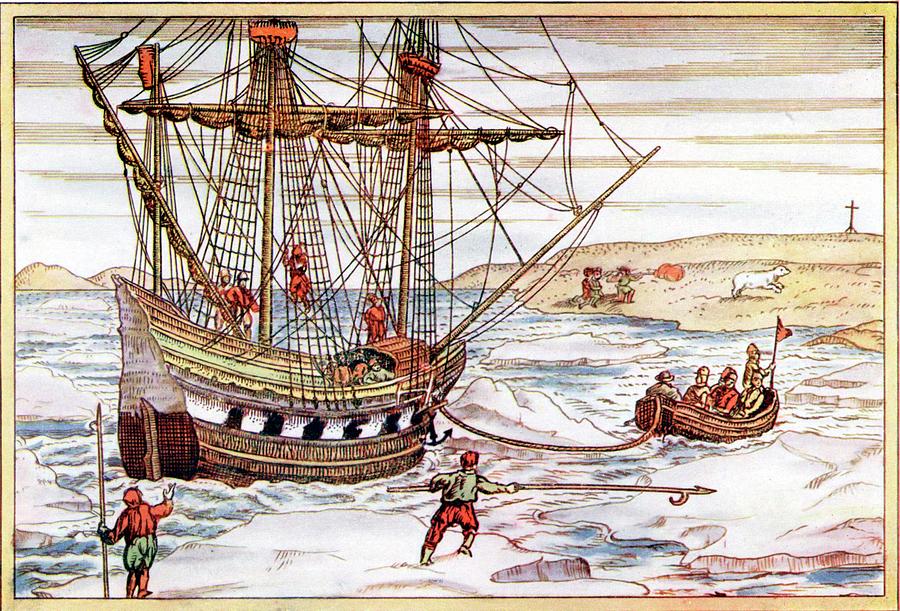Expedition to the Novaya Zemlya archipelago

Already in 1594, great Dutch seafarer Willem Barentsz mentioned memorial crosses erected on Novaya Zemlya by Russian coast-dwellers, fishermen and trappers in his sailing directions. At the beginning of the 20th century, leading European countries fought to establish their national flag at the North Pole very first, sending more and more expeditions to the Arctic. The Russian Empire, with its vast maritime territories in the Arctic, was also interested in the polar region and supported conducting research expeditions. To discover, document and, if possible, preserve the traces of previous explorations – that mission was set for team No. 1, led by 2nd rank captain Sergei Zinchenko, in the summer of 2020.

The Dutch seafarer Willem Barentsz, after whom the cold sea from the Kola Peninsula to the Novaya Zemlya archipelago was named, participated in expeditions along the western coast of Novaya Zemlya three times. On the third expedition, in the fall of 1596, his ship was blocked by ice in the Kara Sea. After ice had broken away on June 14, 1597, the winterers attempted to break free and sail back with two boats, but Captain Barentsz got the scurvy during wintering – he died on June 20 and was buried on Novaya Zemlya.

The harsh Arctic nature has preserved the remains of the great seafarer’s wintering – traces of thetimber work, a leveeing. There is a narrow hollow in the relief, where the crew made a warehouse for equipment during the construction of the hut. New archeological works in the Ice Bay may shed some light on the life of Captain Barents at the last months of his life.

Фото: Сергей Катков
In July 1768, by the empress’ command, the first Russian research expedition led by Fyodor Rozmyslov was sent to Novaya Zemlya. Official instructions of the expedition were to make maps of the Matochkin Strait, measure its depths; if possible, to sail the Kara Sea to the Ob river mouth and along the strait’s coast.
«to explore thoroughly, whether there are any ores, minerals and other unusual stones, crystal, other curious things, salt lakes and so forth, and any special well springs and waters, pearl shells, and animals, birds and sea animals inhabiting the waters there, trees and grasses of exceptional and uncommon character»
Our search team discovered an 18th-century copper cross and a round lead bullet at the wintering site of the Rozmyslov expedition – real evidence of the first official scientific expedition to these places. Following the description of the early 20th century mariners, we managed to find the wintering remains, wrought nails and gun bullets of the second detachment of the Rozmyslov expedition, which had not been found by the historians before.


Фото: Сергей Катков
It is empty, dead around the high rock where Cywolka’s ashes are buried. There is an inscription on the fallen cross: «The ashes of CNNCE lie here. Warrant officer Cywolka passed away on March 16, 1839 and 8 other members died in winter from the scurvy disease. The cross was set by CNS warrant officer Moiseyev»


August 21, 2020. By midnight we anchored at the southern part of Barents Island. On its west coast we will search for the supply depot of the Weyprecht and Payer expedition in 1871-1874. The first, night attempt to land from the south-west to the warehouse location ended in failure. We could not pass the strait by boat, the moraine sediments crossed it with a broad long belt leaving a meter depth and even less in some places. We tried all night long, rubbed the bottom with our keel, got back to the ship with nothing… We stayed in the cabin till 4 am, waiting for a decision, we did not want to lose time. But in the early fifth we finally took a rest, in the morning we will try to enter from the north, from the open sea…

Продовольственное депо австро-венгерской экспедиции К. Вайпрехта и Ю. Пайера. Фото: Сергей Катков
August 22, 2020. We work from morning till 9 pm, with rare breaks. We made buckets for carrying gravel and boxes for wood laying from handy tools, found on the quay. Behind a large block mass we stumble upon two crates. They have marks of rusty tin inside, one contains a yellow stack of paper depicting medals. Gothic texts can be seen, in one place above a beautiful stamp with a queen’s image there is an inscription — LONDON 1872. Presumably it is a certificate of quality for that very «pea sausage». On the other one box lid there are remnants of a black ink inscription: POLAR EXPEDITION, 1872, WHYPRECHT & PAYER. It is s hard to believe… THIS IS A WIN!!!





Despite all the difficulties and the illness, after wintering, G.Ya.Sedov continued to move toward his stated objective – the North Pole. The Arctic took his life to the north of the Franz Josef Land archipelago, and the exact place of his burial has not yet been identified.
In 1937, Russian poet Nikolai Zabolotsky wrote a poem «Sedov», dedicated to the explorer’s exploit:
He holds constant compass in his dying hours,
Surronded by nature ice-trapped and dead blue.
And image of cave-dwelling, bright sunshine power
Was hidden in fog, can be seen only through.
Nikolai Zabolotsky. Sedov
Текст: Сергей Катков, ЦСИ
Фото: Сергей Катков, ЦСИ; Первая фотография: Николай Гернет.
















